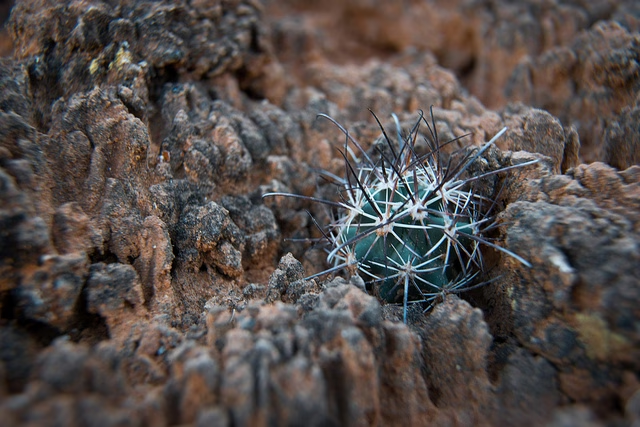
Biological soil crusts (aka biocrusts) are a thin surface layer composed of mosses, lichens, fungi, and cyanobacteria that grow on loose, dry soils worldwide (about 12% of land surface). An important ecological component of dryland ecosystems, biocrusts hold soil in place to prevent erosion, increase water infiltration, facilitate nutrient cycling, and act as a seedling nursery for plants. Biocrusts therefore exert a strong influence on the development and resilience of dryland ecosystems.
But biocrusts are fragile, and easily destroyed by livestock, recreation, and off-road vehicles. Once disturbed, they may take decades to recover. This vulnerability, however, also makes them a useful indicator of desert ecological health.
Biocrusts are prevalent across the Colorado Plateau and at Grand Staircase-Escalante National Monument, where nearly the entire Monument is suitable for their growth, and where both early- and late-successional biocrusts are widespread. As climate change contributes to hotter temperatures and prolonged drought, however, little is known about how biocrusts will respond to these shifts, or the impacts they may have on ecosystems at large.
Three recent studies sought to address this gap by focusing on rehabilitation of disturbed sites with biocrusts and examinations of their nutrient content and flux.
Habitat rehabilitation
As more biocrust is disturbed by human activity or climate change, the need for reliable restoration techniques is growing. A research team led by Sierra Jech of University of Colorado–Boulder recently experimented with methods to cultivate and reintroduce biocrusts to a degraded site on the Colorado Plateau.
First, they collected biocrust samples from the Mojave Desert and Colorado Plateau, which were used to inoculate greenhouse and outdoor soil plots. They measured cyanobacterial community composition and abundance in those settings, with and without growth medium and shade, to evaluate their possible effectiveness for use in rehabilitation. After applying inocula to a degraded site on the Colorado Plateau, they measured community composition and photosynthetic activity after cultivation and five months later.
In a study published in February 2025 in Applied Soil Ecology, the team reported that both greenhouse and outdoor cultivation are viable options for biocrust cultivation, but habitat amelioration was necessary to achieve the best results. Disappointingly, five months after inoculating the degraded site with biocrust, no significant difference in soil function was found. The study helped point the way toward future applications, however, including the limitations of greenhouse cultivation (small scale, not feasible for large projects), for example, and the importance of bacterial diversity during the cultivation stage, to maximize restoration outcomes.
Nutrient content
Because biocrusts play an important role in carbon (C) and nitrogen (N) cycling, it is becoming increasingly important to know where biocrusts are and how they might be affected by ecological change, so that proactive management solutions can be implemented.
A research team led by Dong Yan of China Renewable Energy Engineering Institute, in Beijing, sought to evaluate the use of spectral reflectance to characterize the C and N status of biocrusts on the Colorado Plateau. As described in their August 2024 article in the Journal of Geophysical Research, the team measured the spectral reflectance of 14 representative biocrust species using a spectroradiometer, under both wet and dry conditions. They found that C/N ratios and N concentrations could be accurately predicted based on reflectance, and that the optimal spectral bands to use are 490-600nm and 1,150-1,350nm.
Their results could be applied to predict biocrust occurrence and nutrient levels from multi-spectral imagery collected by satellites. This would provide a low-cost way to map and study biocrust occurrence and change over large landscapes.
Carbon source or sink?
Despite these advances, much uncertainty remains about how biocrusts will respond to increased temperatures and aridity. PhD student Tanner Tainui Aiono, of Brigham Young University, sought to understand how climate change will affect carbon uptake and loss in biocrusts, and the factors that influence it. For example, it is thought that while biocrusts are generally considered a carbon sink, the climate change-driven shift toward less frequent, more severe precipitation events in the Southwest may have the opposite effect, instead causing larger bursts of decomposition and respiration (and release of CO2), with biocrusts becoming a carbon source.
In his December 2024 dissertation, Aiono utilized automated gas exchange chambers chambers to study temperature, humidity, and soil moisture of existing biocrust at an experimental site in Moab, Utah. Results indicated that during warmer summer months greater respiration and less photosynthesis occurs (carbon source); in the winter months, the opposite. Biocrusts near shrubs, where soil moisture was greater, lost significantly less carbon. Data did not support the “burst” hypothesis of rapid respiration following precipitation events.
These results indicate that temperature, rather than precipitation, is the most important abiotic factor driving carbon cycling. In general, soils were losing carbon most of the time, with greatest output during the warmest summer months. Vegetation cover may be influential in slowing carbon loss, suggesting that management efforts to maintain vegetative cover should be prioritized during biocrust preservation.
**
The approved Resource Management Plan for GSENM lists as objectives to “Protect and restore areas of biological soil crust appropriate for the soil type, climate, and landform” and “Emphasize research that builds understanding and improves management of soil resources and biological soil crusts.” The kinds of research described above can and should be done here, too. If you or someone you know is interested in conducting biocrust research on GSENM, please reach out to me at kevin@gsenm.org.
– Kevin Berend, Conservation Programs Manager
[Image courtesy NPS/Neal Herbert]

